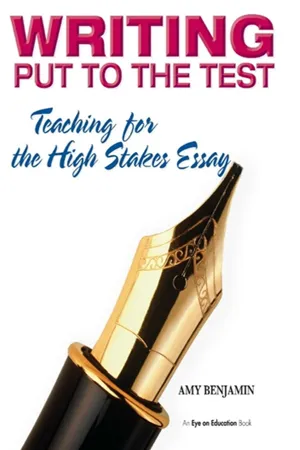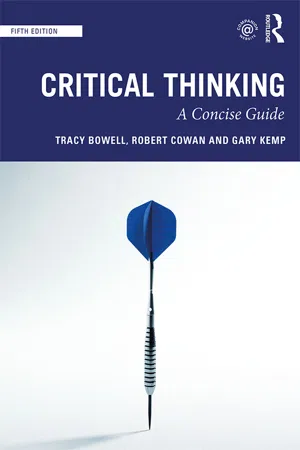Complex Rhetorical Modes
Complex rhetorical modes refer to advanced patterns of organization and presentation used in writing and speaking to effectively convey complex ideas. These modes include processes such as comparison and contrast, cause and effect, and problem-solution, which help writers and speakers to structure their communication in a clear and persuasive manner.
3 Key excerpts on "Complex Rhetorical Modes"
- eBook - ePub
Writing Put to the Test
Teaching for the High Stakes Essay
- Amy Benjamin(Author)
- 2013(Publication Date)
- Routledge(Publisher)
...II Rhetorical Modes 5 Teaching Writing Through Rhetorical Modes Because much of our understanding of the world comes through the recognition of patterns, it is extremely helpful to understand how writing topics fall into the following major rhetorical modes: ♦ Narration ♦ Description ♦ Cause and effect ♦ Classification and division ♦ Comparison/contrast It should be noted that some writing texts condense these categories onto only four rhetorical modes: narration, description, exposition, and persuasion. Each rhetorical mode accomplishes its own purpose. Each comes with its own structure and language. Most text is organized around a predominant rhetorical mode, supported by at least one secondary mode. For example, narration often partners up with description; definition partners with exemplification. Teaching writing through the rhetorical modes, which are also called discourse modes, goes way back to Aristotle. However, this paradigm for teaching writing lost its place at the table of writing instruction in the 1970s and 1980s when “process pedagogy” came into favor. Actually, there’s no reason why instruction in the rhetorical modes needs to compete with writing process instruction: both can be mutually supportive. The advantage of teaching writing through the rhetorical modes, as we will see, is that once we know what mode we’re in, we can build within an existing structure that we already understand. Karen Gocsik, executive director of the writing program at Dartmouth College, says this about discourse mode pedagogy: [M]odes of discourse instruction can be used to lead students systematically through a hierarchical system of cognitive functions. In these classrooms, professors develop assignments that progress through the modes, moving students from the personal narrative to the analytical argument, and from simple organizational strategies that are chronological and spatial, to more complex organizational strategies that are more formally logical...
- eBook - ePub
Critical Thinking
A Concise Guide
- Tracy Bowell, Robert Cowan, Gary Kemp(Authors)
- 2019(Publication Date)
- Routledge(Publisher)
...2 • language and rhetoric • Linguistic phenomena Ambiguity • Vagueness • Primary and secondary connotation • Rhetorical questions • Irony • Implicitly relative sentences • Problems with quantifiers • Quantifiers and generalisations • Aspects of meaning Rhetorical force • Implicature • Definitions • Rhetorical ploys Appeals to specific feelings • Appeal to novelty • Appeal to popularity • Appeal to compassion, pity or guilt • Appeal to cuteness • Appeal to sexiness • Appeal to wealth, status, power, hipness, coolness, etc. • Appeal to fear (also known as scare tactics) • Appeal to ridicule • The direct attack and hard sell • Scare quotes • Trading on an equivocation • Trading on implicature • Many questions (aka leading question or complex. question) • Smokescreen (changing the subject) • Buzzwords, jargon and acronyms • Spin • Gas-lighting • Chapter summary • Exercises Chapter overview : In this chapter we begin by discussing the ways in which particular uses of language can serve to obscure what speakers and writers want to communicate. We will use the label ‘linguistic phenomena’ to refer to these ways of using language. It is important for critical thinkers to become familiar with them and to learn how to rephrase language used in these ways in order to be able to work out precisely what proposition someone is arguing for and which propositions they offer in its support, and to be able to express those propositions as clearly as possible. To provide some background to this discussion and to the discussion of rhetorical ploys that follows, we go on to discuss three aspects of linguistic meaning that are most relevant to these topics. The aim of our discussion of rhetorical ploys is to introduce readers to some common devices in which rhetoric is deployed by speakers and writers to persuade us to do, believe, or desire things and to explain how these ploys are effective at influencing us...
- John Allen, Susan Bureau, Stacey A. Kiggins(Authors)
- 2013(Publication Date)
- Research & Education Association(Publisher)
...Chapter 10 Approaching the Essay Questions: Rhetorical Modes In Chapter 4, we looked at the rhetorical strategies used by authors of nonfiction to help you analyze passages and answer multiple-choice questions. In this chapter we will briefly review rhetorical modes with an eye towards using them effectively in your own essays for the AP English Language and Composition exam. On the style-analysis essay, you will be using rhetorical tools to analyze an author’s writing methods in a passage. On the persuasive and synthesis essays, you will be using these tools to present logical, structured arguments about topics that are provided. It helps to be familiar with these rhetorical modes and methods so that each time you are faced with a prompt you can choose the approach that best helps you accomplish the required writing task. Deciding on Your Writing Purpose The modes of writing you will use on your responses include expository, persuasive, descriptive, and narrative. You might use a combination of all of these on one essay. Before you choose your writing mode, you must decide on your purpose for writing: • To inform or instruct —The essay seeks to explain, describe, or define something. This type of essay should be tightly organized, with a series of main points and supporting details. • To persuade —The essay seeks to convince the reader to believe something or agree with a certain point of view. This type of essay is logically organized to present an argument step by step. • To entertain —The essay seeks to evoke laughter, sadness, suspense, nostalgia, or other emotions. Generally this type of essay has a looser, more improvisatory structure. When you read a writing prompt, think about what it is asking you to do. For example, a prompt might ask you to explain how an author uses irony in a passage to criticize social conditions. Another prompt might instruct you to support or refute an argument, or to take a position on a viewpoint expressed in a passage...


